Honor Award
Tianjin Qiaoyuan Park: The Adaptation Palettes
Tianjin City, China
Turenscape, China and Peking University Graduate School of Landscape Architecture
Client: The Municipal Government of Tianjin City,China
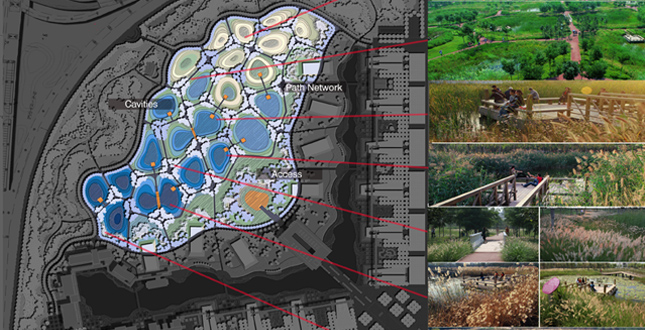 Close Me!
Close Me!Site Plan (also showing positions where the photographs are taken)
Download Hi-Res ImagePhoto: Kongjian Yu / Turenscape
Photo 1 of 15
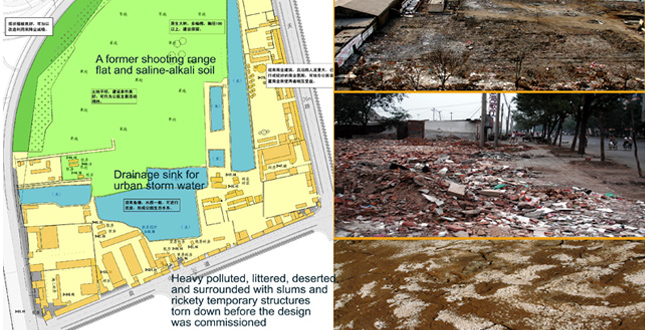 Close Me!
Close Me!The existing conditions of the site: a former shooting range, shown as a garbage dump and drainage sink for urban stormwater, heavily polluted with saline–alkali soil, littered, deserted, and surrounded with slums and rickety temporary structures.
Download Hi-Res ImagePhoto: Kongjian Yu
Photo 2 of 15
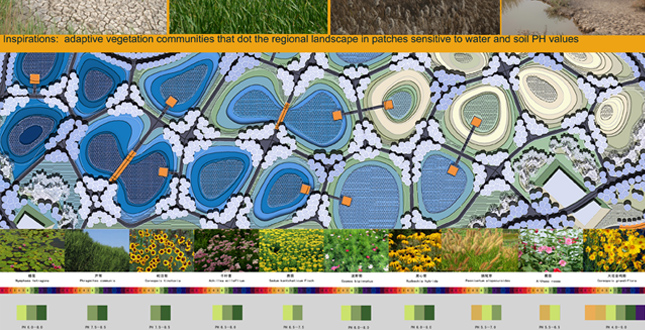 Close Me!
Close Me!Design concept: Let nature work. The adaptation process isvisualized in habitat patches sensitive to water and soil PH values. It was inspired by the regional landscape with patchy habitats sensitive to subtle changes of water and PH values.
Download Hi-Res ImagePhoto: Kongjian Yu
Photo 3 of 15
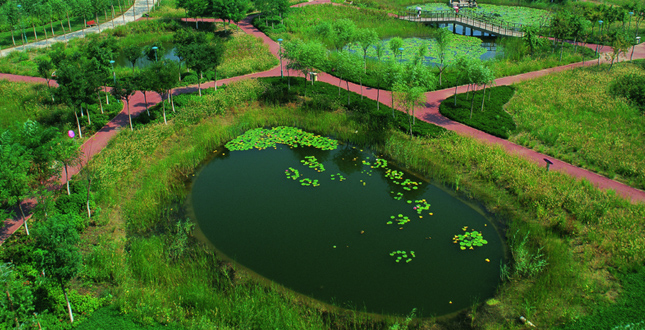 Close Me!
Close Me!The bird's-eye view of the park from the southwest corner showing the diverse patchy landscape of pond cavities occupied by various plant communities (Summer).
Download Hi-Res ImagePhoto: Cao Yang
Photo 4 of 15
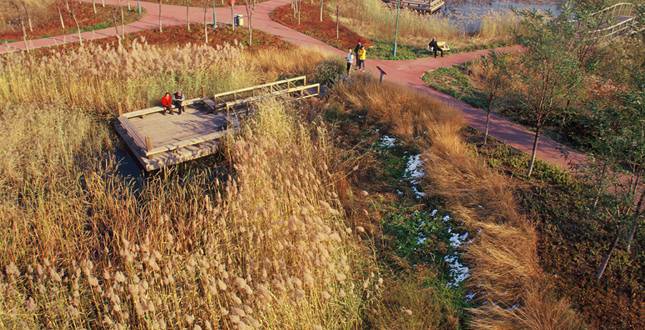 Close Me!
Close Me!The bird's-eye view of the park from the southwest corner showing the diverse patchy landscape of pond cavities occupied by various plant communities (Fall).
Download Hi-Res ImagePhoto: Cao Yang
Photo 5 of 15
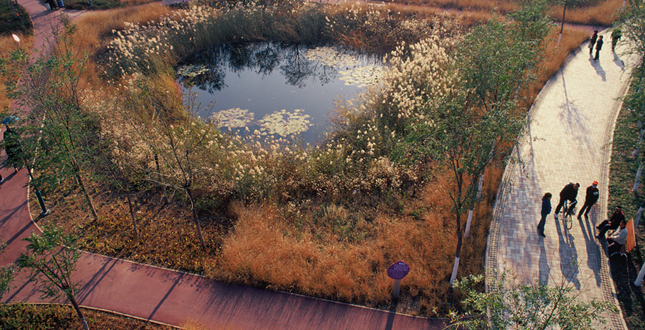
 Close Me!
Close Me!A deep water pond with an environmental interpretation board, occupied by water lily and surrounded on the shore by Chinese pennisetum (Pennisetum alopecuroides) and other native grass.
Download Hi-Res ImagePhoto: Kongjian Yu
Photo 7 of 15

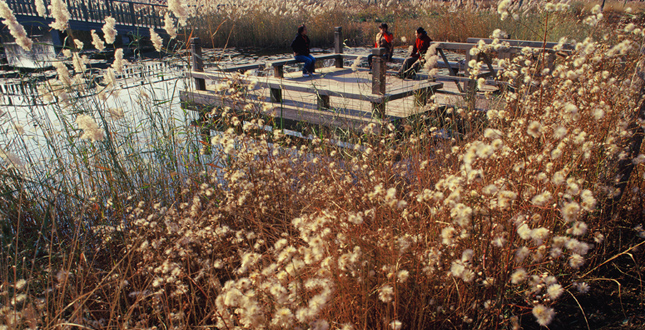
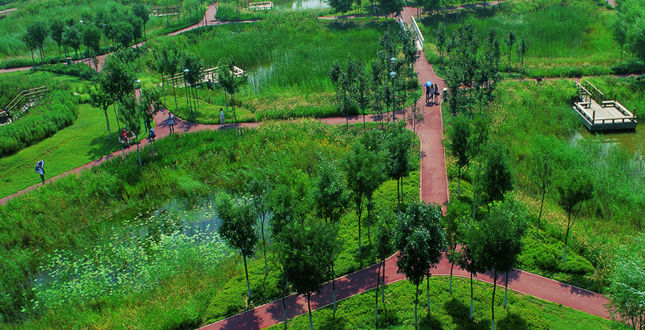 Close Me!
Close Me!Shallow and seasonal water ponds occupied by diverse native plant communities.
Download Hi-Res ImagePhoto: Kongjian Yu
Photo 10 of 15
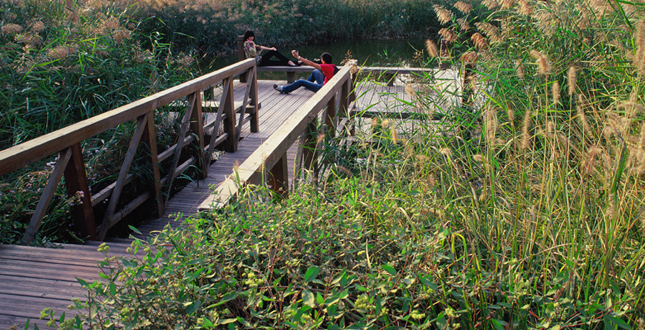 Close Me!
Close Me!One of the shallow water ponds dominated by a reed community at the water's edge, creating a quiet and romantic place in the middle.
Download Hi-Res ImagePhoto: Cao Yang
Photo 11 of 15
 Close Me!
Close Me!One of the shallow water ponds showing the “messy nature” being appreciated by visitors of different ages.
Download Hi-Res ImagePhoto: Cao Yang
Photo 12 of 15
 Close Me!
Close Me!A dry cavity upon a mound above a garbage dump. Occupied by the Aizoon stonecrop (Sedum aizoon), and surrounded by garden cosmos (cosmos bipinnatus) among others, on the edge. A totally different plant community from the water ponds and wet bubbles.
Download Hi-Res ImagePhoto: Kongjian Yu
Photo 13 of 15
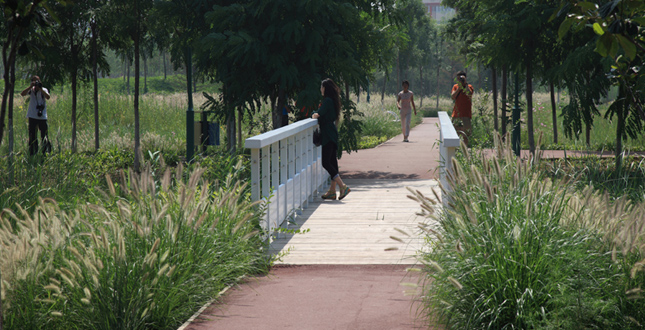 Close Me!
Close Me!An intersection of paths where various ponds and cavities meet becomes an attraction for visitors.
Download Hi-Res ImagePhoto: Kongjian Yu
Photo 14 of 15
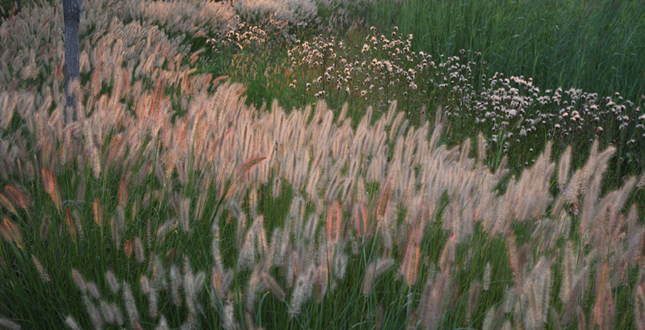 Close Me!
Close Me!The adaptation palette: The diverse plant communities established at the edge of one of the water-collecting cavities with subtle variation in soil and water conditions.
Download Hi-Res ImagePhoto: Kongjian Yu
Photo 15 of 15
Project Statement
Through regenerative design and by changing the landform, the natural process of plant adaptation and community evolution is introduced to transform a former deserted shooting range used as a garbage dump, into a low-maintenance urban park; providing diverse nature's services for the city including containing and purifying stormwater; improving the saline–alkali soil, providing opportunities for environmental education and creating a cherished aesthetic experience.
Project Narrative
—2010 Professional Awards Jury
This is a park of 22 hectares (54 acres) in the northern coastal city of Tianjin, China. Rapid urbanization had changed a peripheral shooting range into a garbage dump and drainage sink for urban stormwater; the site was heavily polluted, littered, deserted, and surrounded with slums and temporary rickety structures, which had been torn down before the design was commissioned. The soil is quite saline and alkaline. Densely populated at the south and east boundaries, the site is bounded on the west and north sides by a highway and an overpass.
In early 2003, in response to residents' call for environmental improvement of the site, the municipal government of Tianjin contracted the landscape architect with the difficult task of an immediate transformation of this degraded site.
The overall design goal for this project is to create a park that can provide a diversity of nature's services for the city and the surrounding urban residents, including containing and purifying urban stormwater; improving the saline–alkali soil through natural processes; recovering the regional landscape with low-maintenance native vegetation; providing opportunities for environmental education about native landscapes and natural systems, stormwater management, soil improvement, and landscape sustainability; and creating a cherished aesthetic experience.
The regional landscape is flat and was once rich in wetlands and salt marshes, which had been mostly destroyed by decades of urban development and infrastructure construction. Though it is difficult to grow trees in the saline-alkali soil, the ground cover and wetland vegetation are rich and vary in response to subtle changes in the water table and PH values.
Inspired by the adaptive vegetation communities that dotted the landscape in this region, a solution for this park was developed called the Adaptation Palettes, which was designed to let nature work. A simple landscape regenerative design strategy was devised, one that included digging 21 pond cavities varying from 10 to 40 meters in diameter, and from one to five meters in depth. The garbage was handled in the earth work. Some cavities are below ground level and some above on mounds.
Through the rainy season and due to the shallow underground water, some cavities turn into water ponds, some into wetlands, some into seasonal pools, and some stay as dry cavities. Through seasons' rain wash and filtration, the saline-alkali soil of the dry cavities get improved, while nutrients deposit in the deeper ponds that catch stormwater runoff.
Diverse habitats were created and the natural processes of plant adaptation and community evolution were initiated. Seeds of mixed plant species were sowed initially to start the vegetation, and other native species were allowed to grow wherever suitable. Through the seasons' evolution, patches of unique vegetation establish in correspondence to the individual wet or dry cavities, and various PH values. The allotment landscape reflects the regional water- and alkaline-sensitive vegetation.
Within some of the cavities are wood platforms that allow visitors to sit right in the middle of the vegetation patches. A network of red-colored asphalt was designed to weave through the palettes and allow visitors to stroll through the patchy landscape. Along the paths is an environmental interpretation system that gives descriptions of natural patterns, processes, and native species.
The park achieved its goals in just two years. Stormwater is retained in the water cavities, allowing diverse water-sensitive communities to evolve. Seasonal changes in plant species occur and integrate with the beauty of the "messy" native landscape, attracting thousands of visitors every day. In the first two months of its opening, from October to November of 2008, about 200,000 people visited the park. It is a successful park which changes its landscape throughout the year period, constantly visited by the community, needs very little maintenance.
This project helps to define the new aesthetics of landscape today, defined by a continuously evolving process. Untidy forms, unplanned biodiversity and nature's "messiness" keep going, letting plants live and expose their genuine beauty to enrich the landscape. The ecology-driven Adaptation Palettes has become a valuable and remarkable site of the community of Tianjin.
Project Resources
Design Principal
Kongjian Yu, International ASLA
Design Team
Shi Chun, Lin Li, Jia Jun, Hu Hanyu, Wang Jun, Qi Sheng, Zhang Bo, Feng Xianjun, Zhang Xuenian, Xinglan, Feng Xianjun, Wang Yunfeng, Su Xinglan






